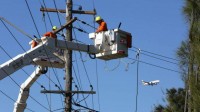Serious concerns as Liberal cuts stretch Western Power maintenance staff
Wednesday 25 Jan 2017This week the Bureau of Meteorology confirmed that Perth’s experiencing its coolest start to the summer in almost a decade. We’ve had weeks of mild temperatures and gentle sunshine.
But if you were going off recent power outages, you’d think Perth has been experiencing a major meteorological event.
Two weeks ago, a minor cold front produced light rain in the southeast of the state. When this light rain hit dust on insulators from the recent dry weather, 35,000 customers lost power. The outages spread from Bunbury in the south to Dandaragan in the north.
We have over 40 crews responding to outages which are impacting power to the 25,000. Read more: https://t.co/lZkVzHMXLb #perthnews pic.twitter.com/XCPLxk2ZQ6
— Western Power (@westernpowerwa) January 12, 2017
The first power outages occurred on the evening of Jan 11th. The last mention of the outage on Western Power’s Twitter account occurred late on January 14th with just under a thousand customers still waiting for restoration in the Wheatbelt area, making it difficult to know when exactly power was finally restored.
In a statement during the blackouts, Western Power said that “crews are working to restore the electricity supply to our customers as quickly and safely as possible.”
We know that’s true. Western Power’s maintenance crews work hard to respond to rapidly emerging situations across the southwest, often in challenging and sometimes dangerous conditions.
But Colin Barnett and Mike Nahan should also take some responsibility for their role in adding to the difficulty of restoring power. Back in April last year they announced 215 jobs would be cut, including maintenance and field staff, as well as office based support staff. This was on the back of 156 jobs lost in the previous months through natural attrition and redundancies.
By June the 215 had grown to 326 jobs made redundant. Then in August a second round saw another 175 go. All of this combined equates to almost 20% of the Western Power workforce having been made redundant or not replaced in the last 12 months. The number of after hours faults and repairs crews has been halved.
As we said at the time, lower staffing levels will mean cuts to preventative maintenance, longer waits on the phone and longer response times when things go wrong. This month’s blackouts are the first visible consequences of these actions.
Light rain and dust caused tens of thousands of homes to go without power. What happens when a severe weather event happens or poles and wires are lost as a result of fire? How long will it take to restore power to homes then?
Worse yet, one only has to look at the tragic case in Victoria of the 2009 Black Saturday bushfires to see the dire consequences of a privately owned electricity system failing to invest in proper maintenance of poles and wires. 173 lives and thousands of homes were lost.
The Bushfire Royal Commission found that “…five of the 11 major fires that began that day were cause by failed electricity assets; among the fires was that at Kilmore East, as a result of which 119 people died.”
The Liberals are cutting back on Western Power staff and costs as they try to make Western Power as attractive as possible ahead of its planned privitisation. But can we afford the increased risk to our power supply and our communities that comes with reducing essential maintenance staff and preventative work?
We’ve been lucky to experience such a mild summer so far. But that won’t always be the case. There will be hot, dry summers in the future that will test our aging electricity network severely. It remains to be seen if a privatised Western Power will have the staff and experience it needs to meet the challenges of the future.

